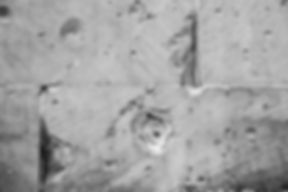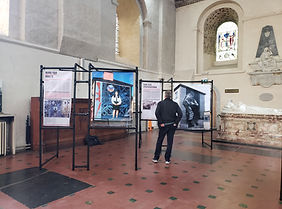
ART, CONFLICT & REMEMBERING:
THE MURALS OF THE BOGSIDE ARTISTS
The exhibition features twelve powerful murals located in the Bogside area of Derry/Londonderry, Northern Ireland. They are created by Tom Kelly, William Kelly, and Kevin Hasson—collectively known as the Bogside Artists. The murals tell the story of the Troubles as experienced by the artists and their local community. They are known as “The People’s Gallery.”
The Bogside was the epicentre of the Troubles, a thirty-year conflict that began on 5th October 1968 with a non-sectarian civil rights march in Derry and ended with the signing of the Good Friday Agreement in Belfast on 10 April 1998.


.jpg)


The Troubles are often portrayed as a deep-rooted sectarian conflict between Catholics and Protestants. Yet, the events that sparked the them were not primarily about religious differences or territorial claims but, as with many global conflicts, about basic civil rights. Since the partition of Ireland and the foundation of Northern Ireland, a Protestant-majority government – supported by a Protestant-dominated police force, the Royal Ulster Constabulary (RUC), and their quasi-paramilitary reserves, the B-Specials – systematically discriminated against the Catholic population of Derry in housing, employment, and voting rights.
In the late 1960s, inspired by the American civil rights movement led by Martin Luther King, Catholic communities in Northern Ireland took to the streets to protest their marginalised status and to demand equal treatment as British citizens. In an effort to suppress further unrest, the British government deployed its armed forces. On 30 January 1972, British paratroopers fatally shot fourteen unarmed civil rights protesters in the Bogside —a tragedy since known as "Bloody Sunday." The walls on which the murals are painted still bear the bullet holes from that day.
The violent actions of the British government against its own citizens—and the subsequent cover-up of the soldiers’ movements —marked a major turning point in the history of the Troubles.
It brought an end to peaceful protest and radicalised many young people, leading them to join the Provisional IRA. As Lord Saville noted in his 2010 report:
What happened on Bloody Sunday strengthened the Provisional IRA, increased nationalist resentment and hostility towards the Army and exacerbated the violent conflict of the years that followed. Bloody Sunday was a tragedy for the bereaved and the wounded, and a catastrophe for the people of Northern Ireland.
Lord Savill, Bloody Sunday Inquiry Report, 15th June, 2010.
Responding to the report, then Prime Minister David Cameron stated:
What happened on Bloody Sunday should never, ever have happened. The families of those who died should not have had to live with the pain and the hurt of that day and with a lifetime of loss.
The murals by the Bogside Artists are the only major work of public art in the UK that commemorates Bloody Sunday and its victims.


ABOUT THE EXHIBITION
The exhibition features large high-res photographs of the murals alongside historic photographs and audio-visual material, placing them in their wider social and political context.
The exhibition has travelled across the UK and has been shown in venues across the UK, including the cathedrals of Coventry, Norwich, Leicester, the universities of Edinburgh and London; Greenbelt Festival; and a range of human rights organisations. Each showing has featured the active participation of the artists through talks, Q&A sessions, and panel discussions.
The exhibition draws attention to a recent chapter in British history that is often overlooked or misrepresented. The art works invite viewers to reflect on the legacy of the Troubles, the role played by the British government, and the human cost of conflict—especially for women and children. At a time of renewed tensions following post-Brexit protocols, and in the face of ongoing civil rights violations worldwide, such reflection is more urgent than ever.
For many visitors coming from conflict or post-conflict societies outside Northern Ireland, the images resonate with their experiences.
Art, Conflict and Remembering:
Art can speak more powerfully than words
Art and Peacebuilding
Peaceful societies are built on a willingness to confront the past and to listen to another’s story. The exhibition fosters dialogue across divides.
The exhibition opens and closes with the following quotes:


A wound must be cleaned out and examined before it will heal; it is the unexamined wound that festers and eventually poisons.
Bishop Desmond Tutu
Our work shows the wounds.
The Bogside Artists
Reconciliation happens when my enemy tells me my story and I am able to say: ‘That is my story’.
Stanley Hauerwas
This is our story: what is yours?
The Bogside Artists
The exhibition invites and enables inclusive, cross-community conversations around the following themes:
-
Ethnic, religious and social discrimination accompanied by violations of fundamental civil rights
-
Radicalisation, extremism and terrorism
-
Dealing with trauma from the past in post-conflict societies
-
Peacebuilding and truth recovery
-
The role of art in remembering the past and imagining alternative futures
For more on art, peacebuilding, and reconciliation









.jpg)



.jpg)


.jpg)


.jpg)


.jpg)









